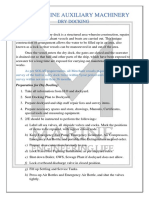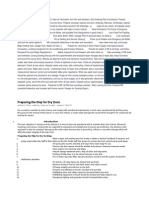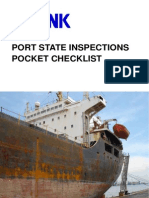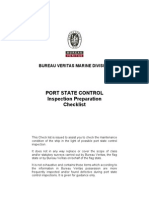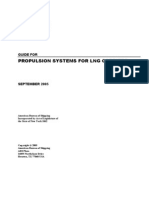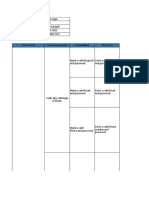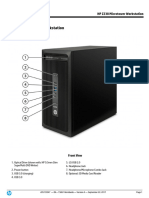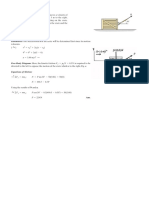Port State Control Check List
Uploaded by
bernardinodinoPort State Control Check List
Uploaded by
bernardinodinoPORT STATE CONTROL CHECK LIST
INTRODUCTION The intensification of Port State Control activities in a world wide growing number of countries intending to eliminate substandard ships. According to the international conventions local port state authorities have the right to board ships without announcement to check whether those ships are complying with the relevant International conventions and regulations. If the authorities verify deficiencies constituting a hazard to safety, health or environment they will detain the ship until such deficiencies have been satisfactorily dealt with. Some countries, instead Of arbitrary boarding of ships in their ports, have introduced or start introducing a targeting system. Among the parameters making up the targeting numeral is also the Owner and the history of his ships in PC. Port State Control officials are boarding the ship for checking the certificates, documents, condition of hull and machinery, equipment and the living conditions as well the adherence to operational requirements in accordance with the relevant instruments as follows: - International Convention for the Safety of Life at Sea (SOLAS) 1974 with its Protocol as amended. - International Convention of Loadlines (LLC) 1966. - International Convention for the Prevention of Pollution from Ships (MARPOL) 1973 with its Protocol. - International Convention on Standards of Training, Certification and Watchkeeping of Seafarers (STCW) 1978. - Convention of the International Regulations for Preventing Collisions at Sea (COLREG) 1972. - Merchant Shipping (Minimum Standards) Convention 1976 (ILO Convention nr. 147).
CHECK LIST
Fire fighting Arrangements
A. Check fire main piping and hydrants for good condition without signs of corrosion or wastage. Check also couplings
and valves for leakage. B. Check fire pumps including prime mover in engine room for proper working condition and sufficient delivery of water pressure. C. Check emergency fire pump including prime mover for proper working condition with sufficient suction and water pressure to be delivered. Check whether crew in-charge is aware of starting procedures. D. Check all fire stations with required equipment of hoses, nozzles, spanners for amount and good condition, nozzle spray adjustments workable and hoses without deterioration. E. Check portable fire extinguishers for amount and good condition including due dates for required servicing. F. Check fireman's outfits for amount, condition and ready availability including breathing apparatus with spare air bottles and their filling status. G. Check fixed fire fighting systems for engine room and cargo spaces for proper working condition including filling status of gas bottles. Check availability of last test records of the systems. H. Check all fire extinguishing arrangement in paint locker with equipment as required to be in place and in good working condition. I. Check all fire dampers, doors and ventilation closing appliances for proper working including gaskets, handles and screws and other mechanical devices. J. Check quick closing devices for tank shut-off and emergency stop of pumps and fans for proper working conditions. K. Check availability of the international shore connection including reducer piece with appropriate bolts and nuts.
CHECK LIST
Live saving appliances
A. Check condition of lifeboats/rescue boats with all parts for proper condition without rust and wastage, whether
blocks and release mechanism are properly maintained and greased as necessary and wire falls are in good condition and turned/renewed as required. Check availability of records about renewal of falls. B. Check lifeboat/rescue boat. inventory about completeness, good condition, dates of expiry for pyrotechnics and foodstuff rations. C. Check launching arrangements for lifeboats/rescue boats for good condition without wastage, including embarkation ladders and illumination for launching and embarkation area.
D. Check lifeboat/rescue boat engines for smooth starting and working condition and that crew is aware of starting
procedures. E. Check condition of life-rafts with hydrostatic releases and launching arrangements including due dates for required servicing. F. Check life buoys/man overboard buoys for amount and good condition including retro-reflective tapes, lights and smoke signals with their appropriate expiry dates. G. Check life-jackets for amount and good condition including whistles, lights and their batteries with expiry dates. H. Check line throwing appliances for completeness and expiry dates of the pyrotechnic units. I. Check parachute signals being placed on the bridge in an appropriate containment for amount, good condition and expiry date. J. Check immersion suits and thermal protective aids for amount and condition including lights or other special attachments.
CHECK LIST
Safety in general
A. Check availability of up-to date fire control plans being posted in accommodation alleyways and one copy in a
prominently marked and weather-tight container outside the deck house. B. Check availability of SOLAS training manual written in a language understood by all crew members. C. Check availability of Instructions Manuals for on board maintenance of lifesaving appliances and whether regular maintenance are recorded. D. Check availability of Operating Instructions for lifesaving appliances posted on-scene. E. Check whether regular drills for fire fightings and ship abandon have been carried out as required and whether they are recorded in the logbook. F. Check whether drills for use of steering gear and switch-over procedures have been carried out and relevant instructions are available. G. Check whether all escape ways are accessible and free of obstructions. H. Check pilot ladders and related boarding arrangements for good conditions being clean and without any damages. I. Check availability of up-to date muster lists written a language understood by the crew members and posted in accommodation spaces. J. Check public alarm systems as for general alarm, steering gear alarm and engineer's alarm for unmanned machinery system.
CHECK LIST
Requirements regarding Loadline
A. Check bulwarks, handrails, cat walks, for corrosion and wastage. B. Check ventilators, air pipes and hatch covers for corrosion, wastage and watertightness including any closing
appliances. C. Check weather tight doors including gaskets and keyhole closing devices for watertightness. D. Check, as far as possible, watertight integrity of ship's hull also in regard to corrosion and wastage.
CHECK LIST
Navigation Equipment
A. Check nautical publications including pilot books, charts, light lists, sailing directions, tide tables, notice to mariners,
code of signals whether updated to the latest amendments/corrections. B. Check navigational instruments as radar, including ARPA devices, echo sounder and speed log for being operational condition. C. Check steering gear including rudder angle indicator as well as emergency steering gear including switch-over devices for operating condition and instructions for handling posted in vicinity. D. Check navigation lights and daylight signaling devices (aldis lamp) for operational condition. E. Check radio direction finder for operational condition including updating of calibration table.
CHECK LIST
Radio equipment
A. Check working condition of main and reserve transmitting and receiving equipment including sources of emergency. B. Check portable VHF handheld radios for survival craft for working condition including batteries with spares. C. Check Radar Transponders for condition and ready availability in case of emergency.
D. Check EPIRB system for correct and float free positioning and expiry date of batteries.
CHECK LIST
MARPOL requirements
A. Check oily water separation system for proper working condition including all piping and discharging arrangements
being as required. Crew in-charge to be familiar with the system in use. B. Check 15 ppm alarm system for proper working condition. C. Check condition of all piping arrangements without any signs of damage or corrosion. D. Check availability of the Oil Record Book and correctness of the required entries. E. Check availability of specially required manuals for tankers, Chemical tankers and gas carriers. F. Check availability of the Shipboard Oil Pollution Emergency Plan with updated communication data as required. G. Check level of engine room bilges and other machinery area for excessive oil contents.
CHECK LIST
Hull and Machinery Condition
A. Check, as far as possible, ship's side shell plates for damage, corrosion, wastage and general watertight integrity. B. Check structural condition of cargo holds in regard to bulkheads, frames, brackets, tank tops, etc. about corrosion,
wastage, damages or cracks. C. Check electric cable arrangements for proper installation and insulation including the main switchboard with insulation mats around it. D. Check engine room for general cleanliness in regard to work and fire safety. E. Check main propulsion system as well as auxiliary engine and power system including emergency arrangement for supply of electric power for proper working condition.
CHECK LIST
Accommodation and Living conditions
A. Check sanitary facilities in crew accommodation for cleanliness and proper condition. B. Check sick bay and medical locker for condition and completeness as required. C. Check ventilation and air conditioning arrangements for proper working conditions. D. Check galley and provision rooms for cleanliness and possible signs of vermin.
CHECK LIST
Ship's documents
Check availability, validity and date range for the next due survey for the following certificates: A. Registry certificate B. Radio station license C. Class certificate D. Loadline certificate Safety construction certificate E. Safety equipment certificate F. Safety radio certificate G. IOPP certificate H. Chemical fitness certificate (if any) I. Gas fitness certificate (if any) J. Compliance certificate for carrying dangerous goods (if any) K. Exemption certificate (s) (if any) L. Tonnage certificate M. Grain loading certificate (if any) N. Manning certificate
You might also like
- English: Quarter 4 - Module 1: Judge The Validity of The Evidence From The Text95% (21)English: Quarter 4 - Module 1: Judge The Validity of The Evidence From The Text28 pages
- Annual Survey Checklist For Oil Chemical TankerNo ratings yetAnnual Survey Checklist For Oil Chemical Tanker11 pages
- Chief Mates Notes Part I: (For Mca Oral Examinations)No ratings yetChief Mates Notes Part I: (For Mca Oral Examinations)49 pages
- Ship Initial Inspection Checklist: Port State Control100% (1)Ship Initial Inspection Checklist: Port State Control34 pages
- Pre Arrival at Load-Disport Checklist (Tanker)100% (4)Pre Arrival at Load-Disport Checklist (Tanker)2 pages
- How To Prepare For Vetting Inspection in The Engine Room?No ratings yetHow To Prepare For Vetting Inspection in The Engine Room?4 pages
- Seamanship Inspect and Report Defects and Damage To Cargo Spaces and Hatch Covers and Ballast Tanks PDF0% (1)Seamanship Inspect and Report Defects and Damage To Cargo Spaces and Hatch Covers and Ballast Tanks PDF8 pages
- How To Conduct Bunker Survey - Marine Surveyor InformationNo ratings yetHow To Conduct Bunker Survey - Marine Surveyor Information1 page
- RightShip - Inspections - Ship - Questionaire - RISQ - 3.0 - v270423 (PDF - Io)100% (1)RightShip - Inspections - Ship - Questionaire - RISQ - 3.0 - v270423 (PDF - Io)142 pages
- Chief Engineer's Standing Orders File 621 (ECR)100% (3)Chief Engineer's Standing Orders File 621 (ECR)2 pages
- PSC Checklist: On Board Maintenance Check ListNo ratings yetPSC Checklist: On Board Maintenance Check List15 pages
- Pre Purchase Condition Survey Report On M V XINHE100% (2)Pre Purchase Condition Survey Report On M V XINHE22 pages
- Passage Planning Guideline For Oceangoing Cargo Ships100% (3)Passage Planning Guideline For Oceangoing Cargo Ships4 pages
- 5 Basic Marine Engineering Principles Every Deck Officer Must Understand100% (2)5 Basic Marine Engineering Principles Every Deck Officer Must Understand12 pages
- 1 - Checklist For PSC Inspections - CompleteNo ratings yet1 - Checklist For PSC Inspections - Complete19 pages
- Capt Deepak Kapoor Oral Questions Mar 18 To Feb 19 PDF100% (2)Capt Deepak Kapoor Oral Questions Mar 18 To Feb 19 PDF62 pages
- Equipos Automaticos de Deteccion de ExplosivosNo ratings yetEquipos Automaticos de Deteccion de Explosivos12 pages
- Us Navy Selects Ion Track S Vaportracer To Fight Terrorism, Improve Force ProtectionNo ratings yetUs Navy Selects Ion Track S Vaportracer To Fight Terrorism, Improve Force Protection2 pages
- Explosives-Detection Systems: Configuration Management and Performance Verification ofNo ratings yetExplosives-Detection Systems: Configuration Management and Performance Verification of20 pages
- Republic of The Marshall Islands Office of The Maritime AdministratorNo ratings yetRepublic of The Marshall Islands Office of The Maritime Administrator5 pages
- 2000 - NIJ - A Guide For Explosion and Bombing Scene Investigation100% (2)2000 - NIJ - A Guide For Explosion and Bombing Scene Investigation64 pages
- Equipos Automaticos de Deteccion de ExplosivosNo ratings yetEquipos Automaticos de Deteccion de Explosivos12 pages
- World S First Large Size: LNG Carrier With Electric PropulsionNo ratings yetWorld S First Large Size: LNG Carrier With Electric Propulsion2 pages
- Propulsion Systems For Future LNG CarriersNo ratings yetPropulsion Systems For Future LNG Carriers4 pages
- Post OPA-90 Vessel Oil Transfer Spill Prevention: The Effectiveness of Coast Guard EnforcementNo ratings yetPost OPA-90 Vessel Oil Transfer Spill Prevention: The Effectiveness of Coast Guard Enforcement22 pages
- Speakout Perason Intermediate End of Course TestNo ratings yetSpeakout Perason Intermediate End of Course Test8 pages
- Per Meter Cost Analysis (From Jani) - CanalNo ratings yetPer Meter Cost Analysis (From Jani) - Canal3 pages
- Literary Genre On Creative Multimedia PresentationNo ratings yetLiterary Genre On Creative Multimedia Presentation21 pages
- Clinical Handbook of Couple Therapy Third Edition Alan S. Gurman All Chapters Instant Download100% (1)Clinical Handbook of Couple Therapy Third Edition Alan S. Gurman All Chapters Instant Download80 pages
- Numerical Investigation of Near-Muzzle Blast Levels For Perforated Muzzle Brake Using High Performance ComputingNo ratings yetNumerical Investigation of Near-Muzzle Blast Levels For Perforated Muzzle Brake Using High Performance Computing9 pages
- Schein (2010:6), Organizational Culture Can Be Defined As "A Pattern of Shared BasicNo ratings yetSchein (2010:6), Organizational Culture Can Be Defined As "A Pattern of Shared Basic5 pages
- Claret College of Isabela: Senior High School0% (1)Claret College of Isabela: Senior High School5 pages













